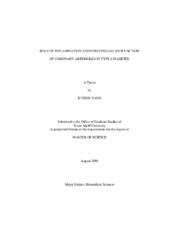| dc.description.abstract | We hypothesized that the interaction between tumor necrosis factor alpha(TNF)/nuclear factor-kappaB (NFkB) via activation of IKK may amplify one anotherresulting in the evolution of vascular disease and insulin resistance associated withdiabetes. The interaction between TNFa and monocyte chemoattractant protein-1 (MCP-1) may contribute to the evolution of vascular inflammation and endothelial dysfunctionin coronary arterioles in type 2 diabetes. To test this hypothesis, endothelium-dependent(ACh) and –independent (SNP) vasodilation of isolated, pressurized coronary arterioles(40-100 μm) from mLeprdb (heterozygote, normal), Leprdb (homozygote, diabetic) andLeprdb mice null for TNF (dbTNF-/dbTNF-) were examined. Although dilation of vesselsto SNP was not different between Leprdb and mLeprdb mice, dilation to ACh was reducedin Leprdb mice. The NFkB antagonist, MG-132, IKK inhibitor, sodium salicylate(NaSal), or Anti-MCP-1 partially restored endothelium-dependent coronary arteriolardilation in Leprdb mice. Protein expression of IKK and IKK were higher in Leprdb thanin mLeprdb mice. The expression of IKK, but not the expression of IKK was increasedin dbTNF-/dbTNF- mice. Leprdb mice showed increased insulin resistance, but NaSal improved insulin sensitivity. Protein expression of TNFa, NFkB, phosphorylation ofIKK and JNK were greater in Leprdb mice, but NaSal attenuated protein expression ofthem in Leprdb mice. The ratio of phosphorylated IRS-1 at Ser307 (pIRS-1)/IRS-1protein expression was elevated in Leprdb mice; both NaSal and JNK inhibitor SP600125reduced pIRS-1/IRS-1 in Leprdb mice. MG-132 or neutralization of TNF reducedsuperoxide production in Leprdb mice. Anti-MCP-1 attenuated superoxide productionand protein expression of nitrotyrosine (N-Tyr), which is an indicator of peroxynitriteproduction, in isolated coronary arterioles of Leprdb mice. Immunostaining resultsshowed that expression of MCP-1 and vascular cellular adhesion molecule-1 (VCAM) isco-localized with endothelial cells and macrophages. Anti-TNFa or anti-MCP-1markedly reduced macrophage infiltration and the number of MCP-1 positive cells.Neutralization of TNFa or anti-MCP-1 reduced the expression of adhesion molecules. Inconclusion, our results indicate that the interaction between NFkB and TNFa signalinginduces activation of IKKb. In addition, TNFa and TNFa-related signaling, includingthe expression of MCP-1 and adhesion molecules, further exacerbates oxidative stressleading to endothelial dysfunction in type 2 diabetes. | en |


